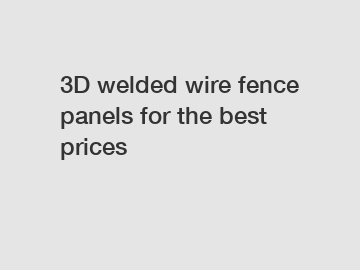How Does Galvanized Steel Cable for Bridge Construction Work?
For more information, please visit Xingtai Steel.
## Understanding Galvanized Steel Cable for Bridge Construction.
Galvanized steel cables play a critical role in bridge construction, providing the necessary strength and durability required to support massive structures and withstand environmental conditions. Here's a step-by-step look into how galvanized steel cable works and why it is utilized in bridge construction.
### Step 1: Material Selection and Initial Processing.
1. **Steel Selection:** The process begins with selecting high-quality steel. The steel composition often includes carbon, manganese, silicon, sulfur, and phosphorus, optimized for tensile strength and durability.
2. **Wire Drawing:** Steel rods are drawn into wires through a series of dies, reducing their diameter to the desired thickness while increasing tensile strength. .
### Step 2: Galvanization Process.
1. **Cleaning:** The drawn wires are cleaned thoroughly to remove any impurities, oils, or oxides. This typically involves an acid bath (pickling) followed by rinsing with water.
2. **Fluxing:** After cleaning, the wires are dipped in a flux solution, usually zinc ammonium chloride, to prevent oxidation before galvanizing.
3. **Hot-Dip Galvanizing:** The wires are then submerged in a bath of molten zinc at temperatures around 450°C (842°F). The zinc reacts with the steel, forming a series of zinc-iron alloy layers topped with pure zinc.
4. **Cooling:** The galvanized wires are cooled and inspected for uniform coating and defects. This zinc coating provides excellent corrosion resistance.
### Step 3: Stranding and Cabling.
1. **Stranding:** Individual galvanized wires are stranded together to form strands. These strands are then twisted around a central core, usually made of the same material, to form a cable. The stranding process enhances flexibility and strength.
2. **Tension Balance:** Tension is carefully controlled during stranding to maintain uniform size and mechanical properties across the entire length of the cable.
### Step 4: Testing and Quality Assurance.
1. **Physical Testing:** Completed cables undergo rigorous testing, including tensile strength, fatigue resistance, and elongation tests. .
2. **Corrosion Resistance Testing:** Specific tests like salt spray tests ensure that the zinc coating provides the expected level of corrosion protection.
Related links:Key Considerations to Keep in Mind When Choosing Sunglasses
Exploring the Benefits and Applications of 316 Stainless Steel ...
The Ultimate Buyer's Guide for Purchasing ornamental metal gates
Top Benefits of Alkali-Free Fiberglass Mesh for Aluminum Casting
How Is Barbed Wire Made
How to Save Money When Buying Galvanised Chain Wire Fencing
10 Things to Consider When Buying Brandt King Cobra Shaker Screen
3. **Visual and Microscopic Inspection:** Both surface and internal inspections ensure there are no hidden defects or weak points.
### Step 5: Installation in Bridge Construction.
1. **Design Integration:** Engineers incorporate galvanized steel cables into bridge designs, calculating load-bearing requirements and dynamic stresses the bridge will face.
2. **Erection:** The cables are transported to the construction site and installed using cranes and other heavy machinery. The cables are placed carefully, and tension is applied using hydraulic jacks or other tensioning devices.
3. **Anchoring:** Once positioned, the cables are anchored securely to the bridge structure, typically using anchor blocks or securement devices embedded in solid foundations to bear the enormous loads.
### Step 6: Maintenance and Longevity.
1. **Regular Inspections:** Bridges undergo regular inspections to monitor the condition of the galvanized cables. Any sign of wear, corrosion, or damage is addressed promptly.
2. **Protective Measures:** Additional protective measures, such as applying grease or employing dehumidification systems, can extend the lifespan of the cables.
### Benefits of Galvanized Steel Cables in Bridges.
- **Corrosion Resistance:** Zinc coating provides a formidable barrier against rust and corrosion, critical for bridges exposed to varying weather conditions.
- **High Tensile Strength:** The steel’s intrinsic strength is enhanced by the galvanization process, making it capable of bearing heavy loads.
- **Cost-Effectiveness:** Despite the upfront cost, galvanized cables offer long-term savings due to their durability and low maintenance requirements.
- **Versatility:** Suitable for various types of bridges, including suspension and cable-stayed bridges.
In conclusion, galvanized steel cables are indispensable in modern bridge construction, offering unparalleled strength, durability, and resistance to environmental factors. The meticulous processes of material selection, galvanization, stranding, and quality assurance ensure these cables can safely support the massive infrastructures they are designed for.
For more information, please visit our website.
Contact us to discuss your requirements of Welded Reinforcing Mesh for Underground Utilities. Our experienced sales team can help you identify the options that best suit your needs.
Related links:Zinc Steel Fence vs. Wood: Which Is Superior for Durability?
Why Choose Zinc Steel Fences Over Wood?
10 Facts You Should Know about Stainless Steel Rope Net
Stainless Steel Rope Net vs. Traditional Nets: Which Wins?
A Beginner's Guide to Ceramic Water Filters
OEM Galvanized Chain Link Fence vs. Standard Options: What's Best?
Guide to Sintered Metal Products











